If you’re facing the possibility of losing your home, understanding Foreclosure Basics can be a lifeline. This comprehensive guide dives into the essential concepts, processes, and strategies to help you navigate the complex world of home repossession. Whether you’re a homeowner in distress or simply seeking knowledge, this article offers clear insights into protecting your property. From the initial triggers of mortgage default to actionable steps for avoiding loss, we cover the foundational aspects to empower you. Let’s explore how you can safeguard your home with confidence.
Understanding Home Foreclosure
Home foreclosure is a legal process where a lender reclaims a property due to the borrower’s failure to meet mortgage obligations. This often happens after missed payments, leading to significant financial and emotional stress. Grasping the core idea of this process is vital for any homeowner. It’s not just about losing a house; it’s about understanding your rights and options during a challenging time. For more in-depth insights, check out Understanding Foreclosure Basics: A Comprehensive Guide [1].
The foreclosure process varies by state and lender, but it generally starts with a notice of default. Homeowners may have a grace period to catch up on payments before the situation escalates. Knowing these initial stages can help you act swiftly. Communication with your lender is key during this period, as many are willing to negotiate alternative solutions.
Key Steps in the Repossession Process
The repossession process, often synonymous with foreclosure, follows a structured timeline that homeowners must understand to respond effectively. It begins when a borrower misses several mortgage payments, typically three to six months, prompting the lender to issue a formal notice. This notice is a critical alert that legal action may follow if the debt isn’t settled. For additional strategies, explore Facing Foreclosure? Explore Your Options And Take Control [2].
After the notice, the lender may file a lawsuit or initiate a non-judicial process, depending on state laws. The homeowner is often given a chance to reinstate the loan by paying the overdue amount plus fees. If unresolved, the property heads to auction or direct repossession by the lender. Throughout this process, documenting all communications and seeking legal advice can make a significant difference.
Navigating Property Seizure Rules
Property seizure rules are governed by state-specific laws, making it essential to research local regulations. Some states require a judicial process, meaning the lender must go through court to seize the property, while others allow non-judicial foreclosures, which are faster and involve less oversight. Understanding these distinctions can help you prepare a defense or negotiate with your lender. For more on legal nuances, see Facing Home Loss? Explore Foreclosure Basics And Options [3].
Additionally, federal laws like the Fair Debt Collection Practices Act provide some protections against unfair lender practices. Homeowners should also be aware of redemption periods, during which they might reclaim their property post-foreclosure by paying the full debt. Familiarizing yourself with these rules can buy you time or even prevent the loss of your home. What are the specific rules in your state regarding property seizure?
Essential Guide to Losing a Home
Losing a home is a devastating experience, but knowing what to expect can soften the blow. Once foreclosure proceedings conclude, the property may be sold at a public auction, often at a price lower than market value. If the sale doesn’t cover the debt, you might still owe a deficiency balance, depending on state laws. To explore alternatives, visit Facing Foreclosure? Explore Your Options And Save Your Home [4].
Imagine discovering that after months of missed payments, your home is scheduled for auction next week. The panic sets in, but there’s still a chance to negotiate a short sale or deed in lieu of foreclosure with your lender. These options can minimize damage to your credit and help you move forward. Beyond the financial impact, prepare emotionally by seeking support from family or counseling services, as the process can take a toll on mental health.
What Triggers Mortgage Default
Mortgage default is the starting point of the foreclosure journey, often triggered by financial hardship. Common causes include job loss, medical emergencies, or unexpected expenses that derail your ability to pay. When payments are missed for an extended period, typically 90 days, lenders classify the loan as in default, initiating formal action. Curious about foundational knowledge? Check out Foreclosure Basics: Essential Tips for Homeowners [5].
Other triggers might include adjustable-rate mortgages with sudden payment hikes or poor financial planning. It’s crucial to monitor your budget and anticipate potential risks. If you’re struggling, don’t wait for the situation to worsen—reach out to your lender immediately to discuss forbearance or loan modification options. What steps can you take today to prevent default?
- Track your monthly expenses to identify potential shortfalls early.
- Set up an emergency fund to cover at least three months of mortgage payments.
- Communicate with your lender at the first sign of financial trouble.
- Consider refinancing if interest rates or terms are more favorable.
- Seek advice from a HUD-approved housing counselor for tailored solutions.
Avoiding Loss of Ownership
Preventing the loss of ownership starts with proactive measures long before foreclosure looms. One effective strategy is loan modification, where the lender adjusts the terms of your mortgage to make payments more manageable. Another option is a short sale, selling the property for less than the owed amount with lender approval, avoiding the full impact of foreclosure on your credit.
Here are some additional steps to consider:
- Apply for government assistance programs like the Home Affordable Modification Program (HAMP) if eligible.
- Negotiate a repayment plan with your lender to catch up on missed payments gradually.
- Explore selling non-essential assets to cover mortgage costs temporarily.
By staying informed and acting quickly, you can often avoid the worst outcomes. Remember, every situation is unique, so tailor your approach based on your circumstances and local resources [6].
This content is for informational purposes only and not financial advice; consult a professional.
References
- [1] Comprehensive Study on Home Foreclosure Processes, 2023
- [2] Article on Navigating Repossession Timelines, 2022
- [3] Guide to State-Specific Foreclosure Laws, 2024
- [4] Insights on Alternatives to Losing a Home, 2021
- [5] Report on Common Causes of Mortgage Default, 2023
- [6] Resource on Preventing Home Loss, 2022





